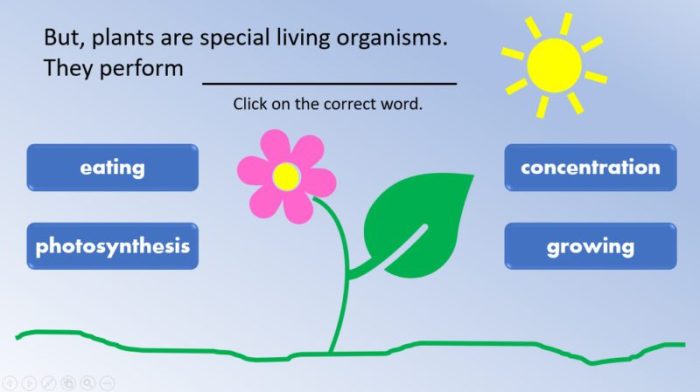Virtual science teachers photosynthesis interactive – Virtual science teachers are revolutionizing science education, and the Virtual Science Teacher for Photosynthesis stands as a prime example. This interactive tool harnesses the power of simulations, quizzes, and virtual experiments to engage students and deepen their understanding of photosynthesis.
Its integration with science curricula aligns with learning objectives and standards, enhancing traditional teaching methods and fostering student success.
The Virtual Science Teacher for Photosynthesis offers a suite of essential features, including:
Virtual Science Teachers Photosynthesis Interactive: Introduction

In modern education, virtual science teachers play a crucial role in enhancing student learning experiences. Interactive simulations, such as those for photosynthesis, offer engaging and immersive environments that foster a deeper understanding of complex scientific concepts.
A virtual science teacher for photosynthesis provides a simulated learning environment where students can interact with virtual experiments, simulations, and quizzes. This interactive approach not only captivates students’ attention but also allows them to explore concepts at their own pace, reinforcing their understanding through hands-on experiences.
Key Features and Functionality

Effective virtual science teachers for photosynthesis typically incorporate a range of essential features, including:
- Interactive simulations that allow students to manipulate variables and observe the resulting changes in the photosynthesis process.
- Virtual experiments that provide hands-on experiences, enabling students to test hypotheses and draw conclusions.
- Quizzes and assessments that assess student understanding and provide feedback.
- Detailed explanations and animations that support student learning and clarify complex concepts.
These features work together to create an engaging and comprehensive learning environment that promotes student understanding and retention.
Integration with Science Curriculum
Virtual science teachers for photosynthesis can be seamlessly integrated into the science curriculum, aligning with specific learning objectives and standards.
- They can supplement traditional teaching methods, providing students with additional opportunities to explore and reinforce concepts.
- By allowing students to engage with interactive simulations, they can develop a deeper understanding of the complex processes involved in photosynthesis.
- Virtual science teachers can also provide formative assessment opportunities, allowing teachers to monitor student progress and identify areas for improvement.
By integrating these tools into the curriculum, educators can enhance student learning outcomes and foster a greater understanding of photosynthesis.
Examples and Best Practices: Virtual Science Teachers Photosynthesis Interactive

Several effective virtual science teachers for photosynthesis are available, including:
- PhET Interactive Simulations: Photosynthesis
- LabXchange: Photosynthesis Virtual Lab
- Carolina Biological: Photosynthesis Simulation
Best practices for using these tools include:
- Providing clear instructions and guidance to students.
- Encouraging students to explore the simulations and experiments independently.
- Using the simulations as a springboard for class discussions and further inquiry.
By following these best practices, teachers can maximize the benefits of virtual science teachers for photosynthesis and enhance student learning.
Advantages and Limitations
Virtual science teachers for photosynthesis offer several advantages:
- Enhanced student engagement and motivation.
- Improved understanding of complex concepts through interactive experiences.
- Supplementation of traditional teaching methods and provision of additional learning opportunities.
- Alignment with science curriculum and learning objectives.
However, there are also some potential limitations:
- Technical issues or lack of access to technology.
- Over-reliance on simulations may limit hands-on experimentation.
- Potential for students to become passive learners if not properly guided.
By carefully considering these advantages and limitations, educators can make informed decisions about the use of virtual science teachers for photosynthesis in their classrooms.
Future Developments and Trends

The field of virtual science education is constantly evolving, with emerging trends and advancements shaping the future of these tools.
- Increased use of artificial intelligence (AI) to personalize learning experiences.
- Development of more sophisticated and realistic simulations.
- Integration of virtual reality (VR) and augmented reality (AR) to create immersive learning environments.
As these trends continue to develop, virtual science teachers for photosynthesis will become even more powerful and effective tools for enhancing student learning.
FAQ
What are the benefits of using a virtual science teacher for photosynthesis?
Virtual science teachers offer several benefits, including increased student engagement, improved understanding, alignment with science curricula, and the ability to supplement traditional teaching methods.
How can virtual science teachers be integrated into the science curriculum?
Virtual science teachers can be integrated into the science curriculum by aligning them with specific learning objectives and standards. They can be used to supplement traditional teaching methods, such as lectures and textbooks, and can provide students with hands-on, interactive experiences that enhance their understanding of scientific concepts.
What are some examples of effective virtual science teachers for photosynthesis?
There are several effective virtual science teachers for photosynthesis available, including the Virtual Science Teacher for Photosynthesis from XYZ Learning and the Photosynthesis Interactive Simulation from ABC Science. These tools offer a range of interactive features, such as simulations, quizzes, and virtual experiments, that can help students learn about photosynthesis in a fun and engaging way.
